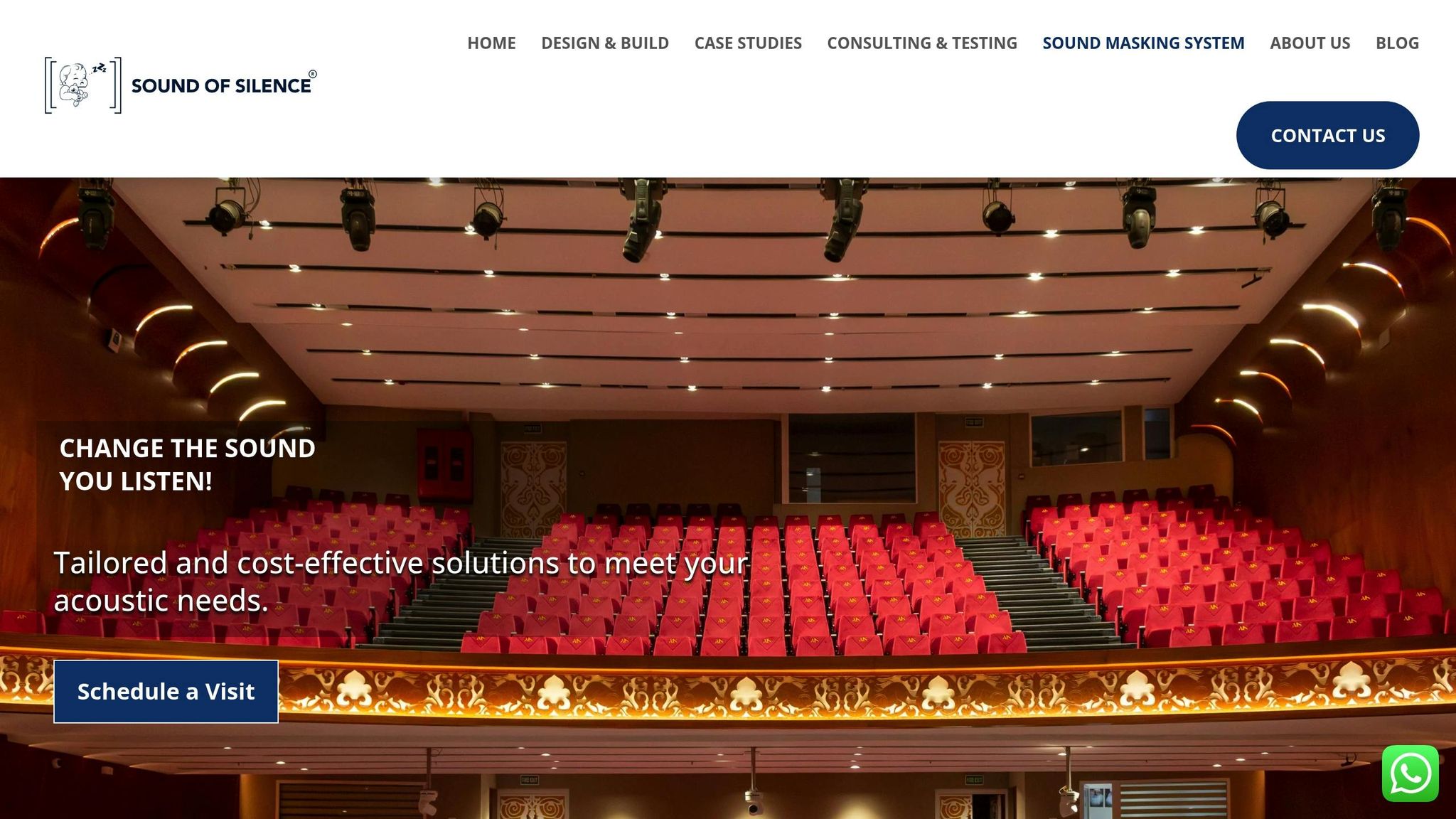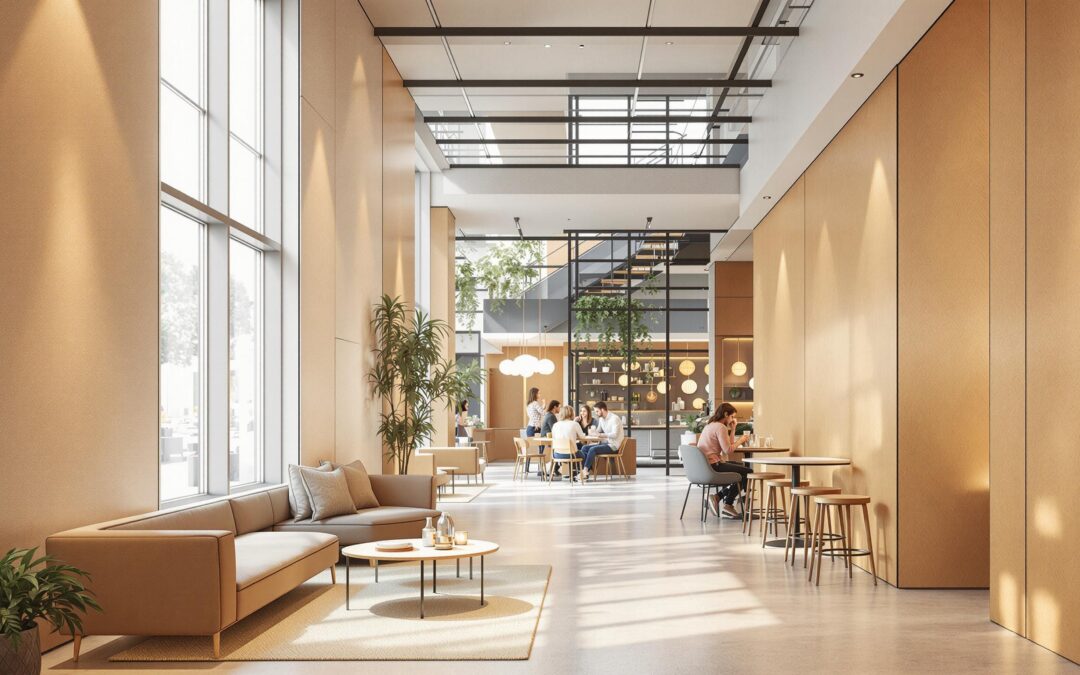Hybrid soundproofing combines passive materials and active noise control systems to create quieter, more comfortable spaces in mixed-use buildings. This approach addresses the unique sound challenges posed by residential, retail, office, and entertainment spaces within the same structure.
Key Benefits of Hybrid Soundproofing:
- Dynamic Noise Management: Adjusts to changing noise levels in real-time.
- Wide Frequency Control: Handles both low and high-frequency sounds.
- Customised Solutions: Tailored to specific building zones, such as gyms, restaurants, and flats.
How It Works:
- Building Structure Components: Floating floors, double-stud walls, and suspended ceilings block noise transfer.
- Sound Control Materials: Acoustic panels, mass-loaded barriers, and damping compounds absorb and reduce sound.
- Electronic Sound Control: Sound masking systems introduce controlled background noise to cover unwanted sounds.
Planning Tips:
- Map Noise Sources: Identify problem areas like gyms or plant rooms.
- Smart Layouts: Place noisy zones (e.g., retail) away from quiet ones (e.g., residential).
- Regulations and Costs: Meet local codes while focusing on key areas for cost efficiency.
Whether for new builds or retrofits, hybrid soundproofing ensures effective noise control. Proper installation and ongoing maintenance keep these systems performing well over time.
Sound Proofing Overview – Critical for multi-family construction!
Core Elements of Hybrid Systems
Hybrid soundproofing systems use a mix of components to manage noise in buildings with multiple uses.
Building Structure Components
The structure of the building acts as the main barrier against noise. Key features include:
- Floating floors: These use resilient mounts to minimise impact noise by isolating the floor.
- Double-stud walls: Designed with resilient framing to block airborne sound.
- Suspended ceilings: Help limit the transfer of noise between floors.
The success of these elements depends on correct installation and the choice of materials to ensure a continuous noise barrier.
Sound Control Materials
The passive layer relies on materials that absorb, reflect, or dampen sound waves. Examples include acoustic panels, mass-loaded barriers, and damping compounds. These materials are placed strategically in walls, floors, and ceilings to target a broad range of sound frequencies.
Electronic Sound Control
Active technology adds another layer of noise management. Sound masking systems, for instance, introduce controlled background noise to reduce speech intelligibility and cover up unwanted sounds. These systems adapt automatically to changes in ambient noise, ensuring consistent acoustic balance throughout the day.
Planning for Mixed-Use Buildings
When designing mixed-use buildings, careful planning is key to managing different acoustic needs effectively.
Noise Source Mapping
Creating a noise map is a crucial first step for effective soundproofing. Using specialised tools, you can measure:
- Airborne noise transmission
- Impact noise from footsteps and machinery
- Structure-borne vibrations
- External noise infiltration
This data helps identify problem areas and guides both acoustic solutions and space layout decisions.
Space Layout Planning
Design spaces with noise levels and usage in mind. Here’s a simple guide:
| Zone Type | Suggested Location | Noise Control Measures |
|---|---|---|
| High-noise (Gyms, Plant rooms) | Lower floors, corners | Heavy isolation, dedicated buffer spaces |
| Medium-noise (Retail, Restaurants) | Middle floors | Standard isolation, corridor buffers |
| Low-noise (Residential, Offices) | Upper floors | Enhanced isolation from external noise |
To improve sound separation:
- Place quiet zones far from noisy areas
- Use service cores and corridors as sound buffers
- Group similar-use spaces vertically
- Face noise-sensitive areas away from busy streets or high-traffic zones
Balancing Multiple Needs
Acoustic planning also involves integrating building systems, meeting regulations, and managing costs:
- Building Services Integration: Align ductwork and piping, install mechanical connections, and use enclosures for noisy equipment.
- Regulatory Compliance: Follow local building codes, meet required acoustic ratings, and maintain fire safety standards.
- Cost Management: Focus on key areas, phase treatments based on occupancy, and use materials that serve dual purposes.
sbb-itb-06ab728
Installation Methods
Installing hybrid acoustic systems requires careful planning and precision, especially when dealing with mixed-use buildings. The process depends on whether the building is new or an existing structure.
New vs. Existing Buildings
The installation process differs significantly between new constructions and retrofit projects. New buildings allow soundproofing elements to be incorporated during construction, while existing buildings require solutions that work around current structural limitations.
| Building Type | Primary Advantages | Key Considerations |
|---|---|---|
| New Construction | – Built-in from the start – Optimal material placement – Lower costs overall |
– Coordination with other trades – Weatherproofing during installation – Step-by-step implementation |
| Existing Buildings | – Focused solutions – Minimal structural changes – Flexible scheduling |
– Limited space for materials – Working around occupants – Increased complexity |
Choosing the right approach – whether integrated during construction or retrofitted – guides the next steps in ensuring a successful installation.
Installation Guidelines
A well-organised installation process ensures the design meets operational performance goals. Here’s how to approach it:
1. Acoustic Testing and Evaluation
Start with detailed acoustic testing and a structural assessment to determine the best materials and methods for the project.
2. Material Selection and Preparation
Select materials based on the specific noise control needs of the space:
- Sound-absorbing panels to manage reverberation
- Mass-loaded barriers to block airborne noise
- Isolation mounts to minimise vibration
- Acoustic sealants to close gaps and joints
3. Step-by-Step Installation
Follow a logical sequence to ensure all elements work together effectively:
- Install vibration isolation systems first
- Add mass-loaded barriers
- Place acoustic panels
- Seal penetrations and joints
- If needed, install electronic sound masking systems
Example Projects
"Our unique selling proposition (USP) revolves around our expertise in Acoustic testing, Consulting, and Execution. By leveraging our specialised knowledge and skills, we ensure precise and reliable outcomes for our clients." – Sound of Silence
Each project is tailored to the specific needs of the space. For heritage buildings, modern acoustic solutions are integrated while preserving historical features. Commercial spaces often require a balance between aesthetics and noise control, using materials that align with the existing design.
After installation, ongoing testing ensures the system performs as expected. Proper installation is critical – every element must work together to provide effective sound control for mixed-use buildings.
Testing and Improvement
Regular Maintenance
Keeping hybrid soundproofing effective in mixed-use spaces means staying on top of regular maintenance. Routine checks help confirm everything is working as it should and catch any problems before they grow.
Key steps include scheduling acoustic assessments, performing visual inspections, and fine-tuning electronic sound control systems. These efforts help preserve soundproofing quality and maintain a quieter atmosphere over time. Regular maintenance is essential for long-term success after installation.
Conclusion
Key Benefits Summary
Hybrid soundproofing systems bring together structural, material, and electronic solutions to meet the needs of mixed-use buildings. They help create quieter, more comfortable environments while maintaining high performance across various spaces, from residential units to commercial areas.
New Developments
Recent progress includes smart acoustic materials that respond to noise changes and improved electronic sound masking. These advancements allow providers to offer tailored, cutting-edge solutions for diverse acoustic challenges.
Contact Sound of Silence

Sound of Silence specialises in delivering customised acoustic solutions for a wide range of projects, from heritage buildings to modern mixed-use developments. Their expertise ensures precise and effective outcomes tailored to each client’s needs.
"Our unique selling proposition (USP) revolves around our expertise in Acoustic testing, Consulting, and Execution. By leveraging our specialised knowledge and skills, we ensure precise and reliable outcomes for our clients." – Sound of Silence
Here’s what Sound of Silence offers:
| Service Category | Components |
|---|---|
| Initial Assessment | Acoustic testing, space evaluation |
| Design Phase | Solution development, system integration |
| Implementation | Installation, performance verification |
| Ongoing Support | Maintenance, system optimisation |
This comprehensive approach ensures your soundproofing system remains effective and efficient throughout its lifespan.

